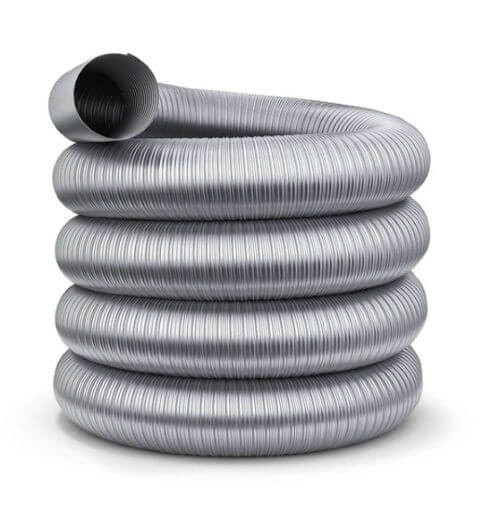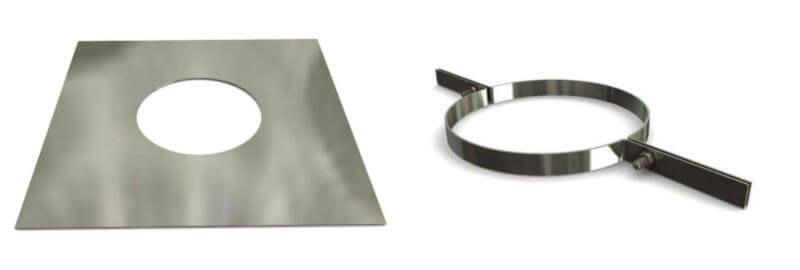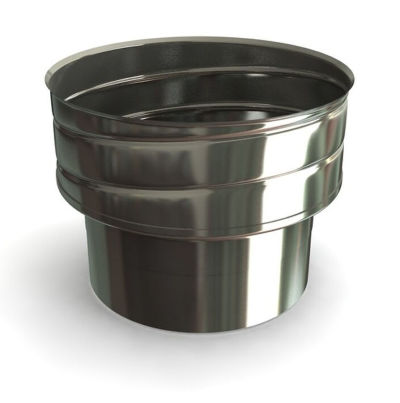How do You Fit a Chimney Liner?
A chimney liner is a vital component to modern stoves, ensuring both their safety and efficiency.
In this guide, we explain everything you need to know about fitting a chimney liner - from what size and material to buy, to how to install it and attach it to your chimney pot...
Can I Install a Chimney Liner Myself?
When it comes to chimneys and flues, it is always best to get a professional to do the job. This is because your flue does a very important job in keeping dangerous carbon monoxide fumes out of your home - plus, any damage could also lead to serious chimney fires.
While you could install a chimney liner yourself if you had the correct equipment and DIY skills, it doesn’t necessarily mean it is safe to do so. It’s always a good idea to get the chimney swept and inspected professionally first to ensure that it is safe to use with no leaks, cracks or other signs of damage.
Secondly, if you are fitting a chimney liner yourself, you must always notify your local building control before any work starts and have it inspected by them when the work is finished - at a cost to yourself. If a HETAS engineer installs it for you, this won’t be necessary as they are authorised to certify the work themselves.
Another point to bear in mind is that fitting a chimney liner will require at least one person to get up on the roof during the entire process. This isn’t something you can do safely while perched along your roof tiles! You will need ladders, scaffolding or a cherry picker to give you stability while you carry out the job.

What Type of Chimney Liner Should I Install?
The most commonly used type of chimney liner today is flexible stainless steel flue liner. Some chimneys are already built with a clay or pumice lining, but you probably wouldn’t install these into an existing chimney.
Flexible flue liners also have some benefits which help make them such a good choice:
- They can easily be removed or replaced if damaged
- They do not require any building work to fit them
- They retain heat well so can help your stove perform as efficiently as possible
There are a couple of different grades of flexible flue liner to choose from, too - either 316 grade or 904 grade.
The 316 grade flue liner is the cheaper of the two and is suitable for burning seasoned wood in your stove. Grade 904 is more expensive, but is required if you will be burning smokeless fuel.
So, if you have a log burner only, 316 grade flue liner should be fine. If you have a multi fuel stove and plan on burning different types of fuel, you might want to go with 904 grade.
What Size Chimney Liner Should You Use?
The size of the chimney liner you need depends on the stove you are fitting it to. The stove manufacturer will state in the manual what diameter flue liner you should fit with it. Remember, the diameter of the flue liner should never be less than the diameter of the stove collar.
Usually, a minimum of 6” flue liner will be required. If the stove is DEFRA approved and the stove manual says it is safe to do so, sometimes a smaller 5” flue liner can be used.
If you choose a different size to what is required (either too small or too large), the stove will not perform properly and could even pose a fire hazard.
Always check the diameter of your chimney before you buy your stove. If, for example, you choose a stove which requires a 7” flue liner but your chimney is only 6”, you will not be able to install it!
How To Install a Flexible Flue Liner...
There are two main ways to install a flexible flue liner - either from the top or from the bottom. Both require at least two people to do the job.
Be sure both of you have the correct safety equipment, including masks, goggles and a hard hat before starting.
To install the liner from the bottom...
- One person will stand on the roof and one will stand by the opening of the fireplace
- The person on the roof will drop a long piece of rope - longer than the length of the chimney - down the flue with a weight on the end
- The person by the fireplace will catch the rope and securely tie it to the top of the flue liner with a nose cone attached
- Back on the rooftop, the first person will pull on the rope, hauling it up the chimney while the person on the bottom helps by pushing when needed
And if you want to install it from the top…
- Again, you will need one person on the roof and one by the fire
- The chimney liner will be uncoiled and carried up to the roof You will drop a rope down the chimney in a similar way, but this time tie it to the bottom of the flue liner. Place a nose cone on the end of it to help guide it down
- You can then start to feed the liner down the chimney, with person two pulling on the other end of the rope to help
Whichever method you use, always make sure your flue liner is installed the right way around! Some have arrows printed on them showing you which way should be pointing upwards.
If you have any bends in your chimney, you might find that the liner gets stuck at some points during the fitting process. If turning it and giving it a few different pushes and pulls doesn’t help, you could try reversing your method to either top-to-bottom or bottom-to-top installation. If you still find it gets stuck, it might be that you need to knock a hole in the chimney to help you push it through - which will need repairing safely, too.
Fitting Flue Liner to a Chimney Pot
There are also a couple of different ways you can fit your flue liner to your chimney pot or cowl…
- With a hanging chimney cowl
- With a top plate and clamp
If you are fitting your flue liner to a hanging chimney cowl, it should be straight forward. The cowl can be inserted straight into the liner and clamped into place. A chimney pot can be placed over it first if preferred, with the cowl sitting on top gripping onto the liner.
Alternatively, a plate can be placed over the top entrance to the chimney. A clamp is then used to grip the flue liner and hold it in place over the top of the plate. A chimney pot or rain cap can then be fitted over it.

Fitting a Flexible Flue Liner to a Stove
To attach the flue liner to the stove, you will need a stove pipe adaptor. The upper part of the adaptor needs to be the same diameter as your flue liner, and the lower part needs to be the same diameter as your stove pipe.
At the bottom of the chimney, the liner should pass through a register plate to seal it off - you need one with a hole the same size as your liner.

If you need any help in finding out which parts you need for your chimney liner installation, just contact us today at Trade Price Flues - our friendly team has all the knowledge needed to get yours up and running!
Shop Flue Liner Fitting Kits Online
More guides from the Trade Price Flues blog…
Does My Chimney Need a Liner? | Do You Need a Chimney Cowl on Your Chimney?
Latest Articles
-
Air Pollution Down in the UK Despite Record Wood Burner Sales
Great news! Wood-burning stoves, once considered environmental villains, have transformed into eco-f …18th Apr 2024 -
A Guide to Stove Installation in Lodges, Sheds, and Shepherd’s Huts
Shepherd’s huts, lodges, and sheds have become increasingly popular as charming retreats or alternat …25th Mar 2024 -
Pinned vs. Pinless Moisture Meters: Which is Best for Firewood?
When you collect or buy firewood, it usually starts very moist inside. Using sopping wet wood to bur …4th Mar 2024






